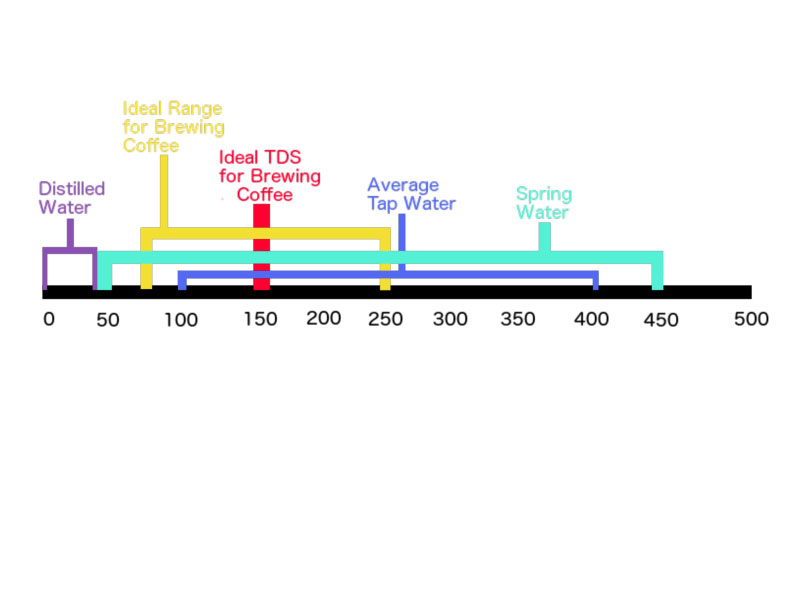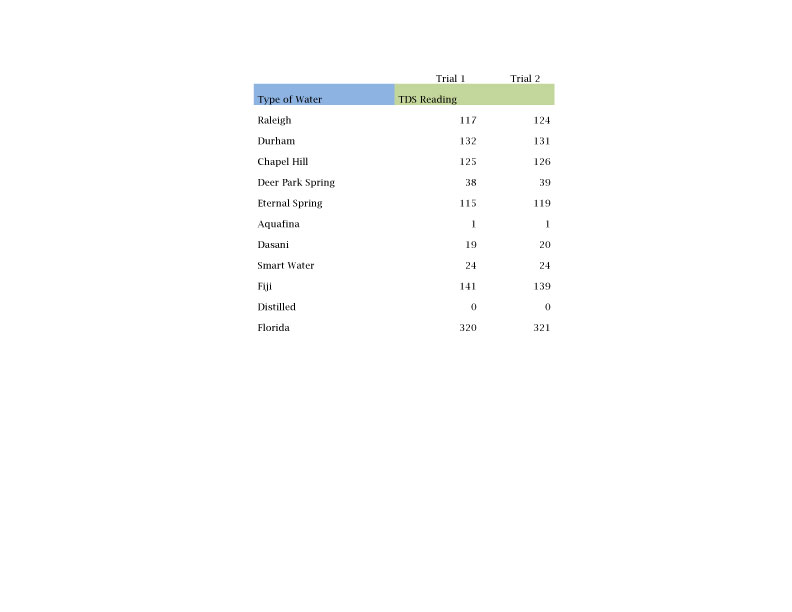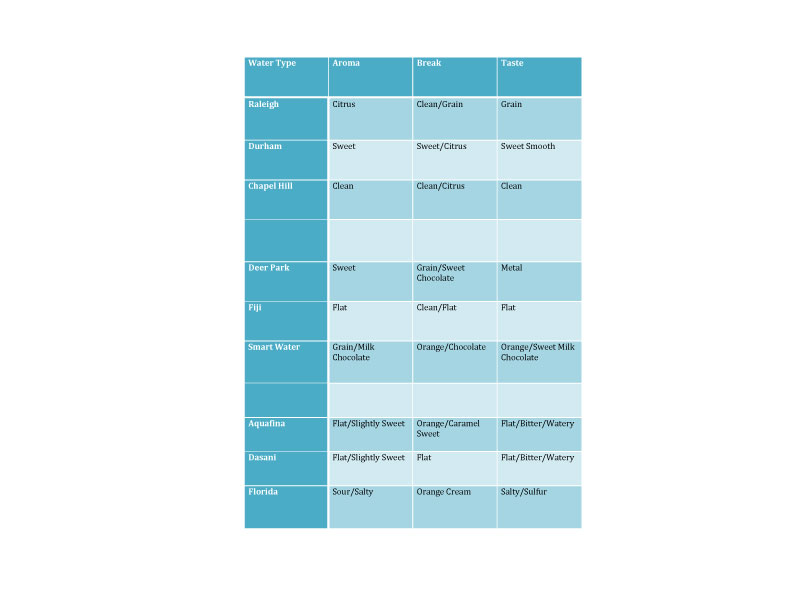What is TDS?
To make a great cup of coffee you not only want the best coffee beans available but also the best water. One of the most important aspects to look at when rating the quality of water is the TDS. TDS stands for Total Dissolved Solids. A TDS measurement represents the total concentration of dissolved substances in the water, which can include minerals, salts, and other solids (1). The amount and type of solids that are dissolved in the water will affect its flavor. Because coffee is about 96 percent water, the TDS of water used in the brewing process will greatly affect the quality of the finished product.
TDS readings vary greatly between different kinds of water. Most distilled water has a TDS of 0 ppm (parts per million). During the distillation process steam is condensed from boiling water and the result is pure water with no dissolved solids. Spring water on the other hand has a relatively high TDS, which can range from 50 to 450 ppm (2). This is because the water picks up different minerals and salts on its journey through underground rock passages and cracks in the earth on its way to the spring. The result is water with a high level of dissolved solids. Tap water is somewhere in between these two. Ideal tap water ranges from 100-150 ppm while average tap water can range from 100-400 ppm (2). So what does this all have to do with coffee?
The TDS of water not only can affect the initial flavor of a cup of coffee but it can also affect the extraction process. The idea is that low TDS waters tend to over extract coffee. There are little to no solids dissolved in these waters so they have a greater ability to absorb coffee material from the ground beans. This will lead to a coffee that is bitter and dry. On the other hand, high TDS waters often have high mineral contents and tend to under extract coffee. These waters already have a high level of solids dissolved in them and will have less capacity to absorb coffee material from the coffee grounds. This may lead to a coffee that is sour or lacking sweetness. According to the Specialty Coffee Association of America (SCAA) the ideal TDS range for the water used to brew coffee is 75-250 ppm. The target TDS is 150 ppm (3). The target TDS of 150 ppm should lead to a properly extracted cup of coffee with balanced flavors and acidity.

Our TDS Experiment
This summer we decided to set up our own test to see the differences in coffee brewed with several waters all with varying TDS amounts. First we selected several different waters and measured their respective TDS amounts. We chose 3 city waters (Raleigh, Durham, and Chapel Hill), 3 treated waters (Dasani, Aquafina, and Smart Water), 2 spring waters (Deer Park and Eternal Spring), and also Fiji, distilled water, and Florida tap water. We recorded their TDS values in this chart.
Cupping
After we collected the different waters and recorded their TDS values, we set up a coffee cupping. We did the cupping in 3 different phases with three waters being used in each phase. We used the same Costa Rica coffee beans throughout this cupping as a control making water the varying element i.e. the independent variable. With the help of Marcos, manager at Brew Coffee Bar, we were able to pick up on differences in aroma and flavor complexities with each of the different waters. Here is what we discovered in our cupping.
Coffee Tasting at HQ Raleigh
After this initial cupping we set up a final tasting at HQ Raleigh. There, we set up two stations each with three sets of coffee brewed with different waters. At station 1 we had coffee brewed with Raleigh, Durham, and Chapel Hill waters and at station 2 we had coffee brewed with Deer Park, Dasani, and distilled water. Again we used the same Costa Rica coffee beans that we used in the cupping to maintain control and consistency. We asked people to go to a station and try the coffee brewed with each different type of water. Next we asked them to fill out a brief survey to see what they thought of the different coffees they tasted. The survey ranked citrus, sweetness, bitterness, and overall enjoyment of the coffee on a 5-point scale with 5 being the strongest score. The scores were averaged and are posted below.
Station 1 *5 point scale, 5 is strongest
Raleigh
| Citrus | Sweetness | Bitterness | Overall Enjoyment |
| 3.2 | 2.5 | 4.2 | 3.1 |
6 out of 8 people described coffee brewed with Raleigh water as bitter. A few people said that it also had a metallic taste while some thought that it had a strong clean taste. Raleigh did have the lowest TDS at 120 ppm, which supports our research that lower TDS waters tend to over extract coffee.
Durham
| Citrus | Sweetness | Bitterness | Overall Enjoyment |
| 3.4 | 2.7 | 3.2 | 3.5 |
Most people found the coffee brewed with Durham water to be more balanced and less bitter. It also was ranked slightly sweeter and scored a higher overall enjoyment score. Durham (132 ppm) had the highest TDS among these waters only slightly higher than Chapel Hill (125 ppm).
Chapel Hill
| Citrus | Sweetness | Bitterness | Overall Enjoyment |
| 2.7 | 3.8 | 2.6 | 3.9 |
The Chapel Hill coffee ranked highest on overall enjoyment between these three city waters. It scored the highest sweetness rating and lowest bitterness rating which made it a favorite among those who tried these coffees. Chapel Hill had a TDS of 125
Station 2
Deer Park
| Citrus | Sweetness | Bitterness | Overall Enjoyment |
| 2.2 | 2.7 | 3.7 | 3 |
When it came to this Deer Park coffee people were undecided overall. Some people thought that the coffee tasted bitter and citrusy while others thought it tasted mild, smooth, and even sweet. It ranked in the middle for overall enjoyment.
Dasani
| Citrus | Sweetness | Bitterness | Overall Enjoyment |
| 1.8 | 2.7 | 2.8 | 3.5 |
Dasani also had mixed reviews. Some thought that the coffee had a smooth taste and others said it tasted flat and less flavorful than the other coffees. Overall I think everyone found this to be at least a drinkable coffee and it ranked as the highest in overall enjoyment at this station.
Distilled Water
| Citrus | Sweetness | Bitterness | Overall Enjoyment |
| 1.5 | 2.5 | 2.3 | 2.3 |
The distilled water, which had a TDS of 0, ranked the lowest in overall enjoyment at this station. This coffee was described as bland and lacking any flavor.
Coffee Balance
Now, lets talk coffee for a bit and the complexity of a good cup of coffee. It is a daunting task to standardize qualities that make a good cup of coffee however, the qualities we scaled above, do just that. So take our good cup of coffee opinion within context.
Coffee tasting experts look for a balance of citrus (acidity), sweetness, and bitterness. We look for the good bitterness that reminds you of dark chocolate. An even balance between all three elements creates a complexity for the drinker and can be achieved through the processing, roasting, and brewing methods, when done well.
For experiment sake, we brewed coffee the exact same way for all types of water. With this method, it does not exclusively state that one particular water is absolutely better than another. We simply wanted to display a difference of waters to our communities.
In defense of Raleigh City Water, which came in last compared to Chapel Hill and Durham, if we were to adjust some brew parameters to balance out the coffee brewed with Raleigh City Water, it would certainly be more competitive with Durham and Chapel Hill. This is where a good barista comes in as an asset to a coffee shop.
A good barista will recognize the balance needed to brew a good cup of coffee and make adjustments to brewing methods in order to achieve this final step. Since the City of Raleigh Water was over extracting coffee brewed in the same parameters of City of Durham and Chapel Hill waters, a coffee brewer would need to adjust the brew time and or coffee grind consistency in order to balance out any bad bitter notes.
Conclusion
While the SCAA sets a target TDS range of 75-250 ppm and an ideal value of 150 ppm these are simply guidelines. It is important to note that while two waters may have the exact same TDS values they can have totally different flavor profiles. An extreme example would be if we dissolved 10 grams of salt into a liter of water and 10 grams of sugar into another liter of water. These waters might end up having the same TDS values but they would obviously taste completely different.
The idea is that the TDS alone affects the extraction process. Low TDS waters tend to over extract coffee. There are little to no solids dissolved in these waters so they have a greater ability to absorb coffee material from the ground beans. This will lead to a coffee that is bitter and dry. On the other hand, high TDS waters often have high mineral contents and tend to under extract coffee. These waters already have a high level of solids dissolved in them and will have less capacity to absorb coffee material from the coffee grounds. This may lead to a coffee that is sour or lacking sweetness.
This being said, what exactly is dissolved in the water will definitely affect its flavor and the flavor of a cup of coffee brewed with that water. This is why we saw differences in coffee brewed with each type of water. Even thought the city waters were fairly close in TDS values (R-120, CH-125, D-132), they each presented different aromas and flavor profiles because of the different kinds of solids dissolved in each water.
We were very surprised at the differences in flavor between coffee made with water from Raleigh, Durham, and Chapel Hill. The coffees brewed with the bottled waters also presented a wide variety of flavors and aromas compared to each other. We would like to point out that we did use the exact same brewing methods for each water during our tasting at HQ Raleigh. We mention this because while this method may have brought out certain qualities in the Durham or Chapel Hill waters we could have easily tweaked some aspects of the brewing to dial in anyone of the waters. So in this way the TDS serves as a useful guideline that a barista or coffee connoisseur can use to help dial in their particular cup of coffee.
References


